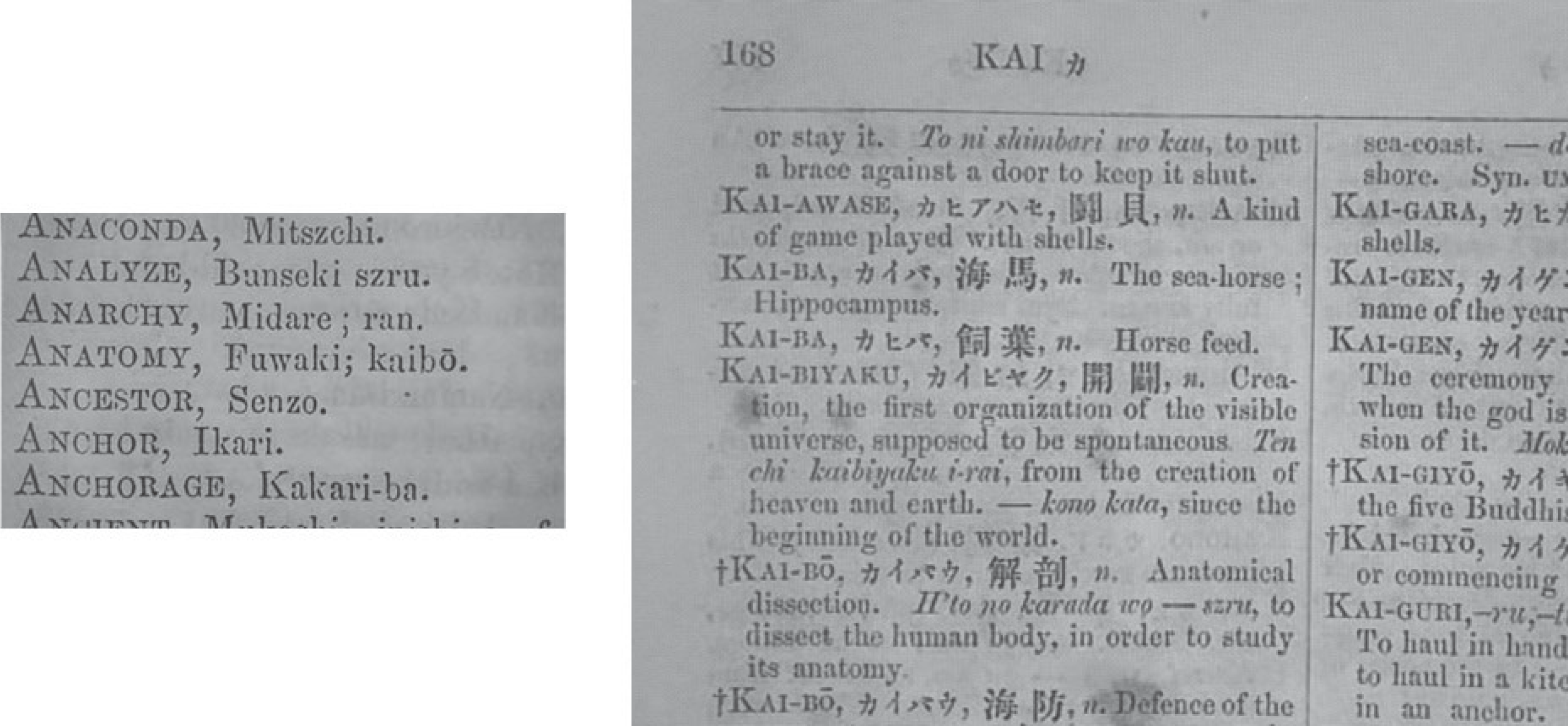1. Sugita G. Kaitai Shinsho. Suharaya Ichibee. Japan. 1774. Japanese.
2. Hepburn JC. Japanese English Dictionary. 1867. Available from. http://www.meijigakuin.ac.jp/mgda/waei/search/?lang=&book=0037&page=13&zoom=0&index=1. Japanese.
3. Leidy J. Kaibokunmo, Keimogisya, Osaka, Japan. 1876. Japanese.
4. Kim PS. Anatomy (translated version of Practical anatomy; Imada S. ed. 1887∼1888). Jejungwon. 1906. Korean.
5. His W. Die Anatomiche Nomenclatur. Nomina Anatomica. Arch Anat Entwick Suppl. 1–183. 1895.
6. Eycleshymer AC. Anatomical names. Especially the Basle Nomina Anatomica. William Wood & Company. 1917.
7. Dorland's illustrated medical dictionary. 32nd ed. Elsevier. 2012.
8. Stedman's medical dictionary. 28th ed. Lippincott Williams & Wilkins.;2005.
9. Nomina Anatomica. 1st. ed. The Williams & Wilkins Co. Baltimore. 1956.
10. Nomina Anatomica. 2nd. ed. Excerpta Medica. Amsterdam. 1961.
11. Nomina Anatomica. 3rd. ed. Excerpta Medica. Amsterdam. 1968.
12. Nomina Anatomica. 4th ed. Excerpta Medica. Amsterdam.
13. Nomina Anatomica. 5th ed. The Williams & Wilkins Co. 1983.
14. Nomina Anatomica. 6th ed. Churchill Livingstone. Edinburgh. 1989.
15. Donath T. Anatomical Dictionary with Nomenclatures and Explanatory Notes. Pergamon Press. 1969.
16. Federative Committee on Anatomical Terminology. Terminologia Anatomica. Thieme. Stuttgart. 1998.
17. Federative International Committee on Anatomical Terminology. Terminologia Histologica. Wolters Kluwer. Lippincott W & W. Philadelphia. 2008.
18. Federative International Programme on Anatomical Terminologies. Terminologia Embryologica. Thieme. Stuttgart. 2013.
19. Otsuki G. Revised Kaitai Shinsho. Tokyo, Japan. 1798. Japanese.
20. Udagawa G.Fujii H. Ihan Teiko. Seireikaku. Japan. 1805. Japanese.
21. Taguchi K. Kaiboranyo. Eirando shimamura risuke. Tokyo, Japan. 1877. Japanese.
22. Ootori R. Transition of the use of anatomical terms in medicine. Nihon Ishigaku Zasshi. Issue 1179–1190. Tokyo. Japan. 1932. Japanese.
23. Japanese association of anatomists. Terminologia Anatomica Japonica. 2nd ed. Maruzen publishing Co. Ltd. Japan. 1947. Japanese.
24. Japanese association of anatomists. Terminologia Anatomica Japonica. 11th ed. Maruzen publishing Co. Ltd. Japan. 1969. Japanese.
25. Japanese association of anatomists. Terminologia Anatomica Japonica. 12th ed. Maruzen publishing Co. Ltd. Japan. 1987. Japanese.
26. Japanese association of anatomists. Terminologia Anatomica Japonica. 13th ed. Igaku-Shoin Ltd. Japan. 2007.Japa–nese.
27. Korean associations of anatomists. Korean Anatomical Terminology, 1st ed. Choesin Euhaksa. Seoul, Korea 1978. Korean.
28. Korean associations of anatomists. Korean Anatomical Terminology, 4th ed. Academia. Seoul, Korea 1996. Korean.
29. Omochi S. Anatomical terms with their origins and grammaticals. Maruzen publishing Co. Ltd. Japan. 1950.Japa–nese.
30. Yoshioka S. Kuria K. Anatomical Terms: Their origin, construction and pronunciation. Igaku-Shoin Ltd. 1968.Japa–nese.
31. Hutamura R. Kinseikaibogaku. 17th ed. Kaneharashoten. 1932. Japanese.
32. Korean associations of anatomists. Korean Anatomical Terminology, 3rd ed. Gyechuk Munhwasa. Seoul, Korea 1990. Korean.
33. Selection committee of Anatomical terms. Terms of human anatomy. Science Publishing Co. 1991. Chinese.
34. Korean associations of anatomists. Korean Anatomical Terminology, 5th ed. Academia. Seoul, Korea 2005. Korean.
35. Korean associations of anatomists. Korean Anatomical Terminology, 6th ed. Academia. Seoul, Korea 2014. Korean.
36. Hojo T. Japanese anatomical terminology (Nomina Anatomica Japonica) from the educational view point (1) – Sune and Nezumi –. J UOEH. 1984; 6:433–436. Japanese.
37. Korean associations of anatomists. Korean Anatomical Terminology, 2nd ed. Choesin Euhaksa. Seoul, Korea 1981. Korean.
38. Korean associations of anatomists. Korean Histological and Embryological Terminology, 1st ed. Soomoonsa. Seoul, Korea 1980. Korean.
39. Korean associations of anatomists. Korean Histological and Embryological Terminology, 2nd ed. Soomoonsa. Seoul, Korea 1982. Korean.
40. Rouvière H, Delmas A. Anatomie Humaine. Tome 3. 13th. ed. Masson. 1991.
41. Korean Big Dictionary. Social Science Publishing Co. 1992. North Korean.
42. Skinner HA. The Origin of Medical Terms. 2nd. ed. The Williams & Wilkins Co. 1961.
43. Lee JK. The new dictionary of foreign words in modern Korean. Hansung Books. Seoul. 1937 Korean.
44. Tekiner H, Acer N, Kelestimur F. Sella turcica: an anatomical, endocrinological, and historical perspective. Pituitary. 2015; 18:575–578.

45. Barcley J. New anatomical nomenclature, relating to the terms which are expressive of position and aspect in the animal system. Edinburgh, Ross and Blackwood. 1803.





 PDF
PDF ePub
ePub Citation
Citation Print
Print


 XML Download
XML Download